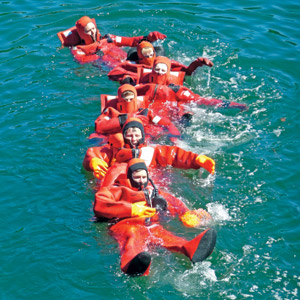In this month’s column, and a second installment to come in our next issue, I want to address the implementation of new requirements for commercial fishing vessels established by the Coast Guard Authorization Act of 2010 and the Coast Guard and Maritime Transportation Act of 2012.
These acts made significant changes to Chapters 45 and 51 of Title 46 (USC) that will be reflected in amended regulations (Parts 28 and 42 of Title 46 CFR).

A qualified Coast Guard-approved marine drill instructor, Fred Mattera of Point Judith, RI is the owner/president of North East Safety Training Co. (NESTCo), which conducts fishing vessel drills and inspections and basic safety training workshops.
These new requirements are set to go into effect by the dates set forth under the law.
Commercial fishermen here in the Northeast are desperately attempting to adjust to the draconian reduction of groundfish quotas and shifting efforts into alternative fisheries – initiating a possible capacity issue.
These conditions are forcing smaller vessels to go further, and stay out longer with less crew in order to survive and be cost effective.
So are these management regulations addressing the 10th Standard of the MSA, “promoting safety at sea?”
Not certain I would agree.
Vessel construction, classification, and loadlines are the new buzzwords that the commercial fishing industry must address in order to comply with the new safety regulations presently and in the near future.
Will compliance hamper the industry triggering additional economic hardship?
Will Congress provide direct funding or low interest funding to meet the cost?
Should the states that received the disaster relief funds set aside monies to assist the industry?
Does this become another cog in the wheel of consolidation?
All good questions, I believe
In order for you to make a prudent decision, it is imperative you have a sound understanding and awareness of these new safety regulations, so I will offer my best interpretation.
Vessel construction & classification
For newly built vessels:
The 2012 Act amended 46 USC 4503 by adding a new subsection (e) that states, “For the purposes of this section, the term “built” means, with respect to a vessel, that the vessels construction has reached any of the following stages: 1) The vessel’s keel is laid, or 2) construction identifiable with the vessel has begun and assembly of that vessel has commenced comprising of at least 50 metric tons or one percent of the estimated mass of all structural material, whichever is less.
The 2010 act initially amended 46 USC 4503 to add a requirement that commercial fishing vessels at least 50’ overall in length (foremost part of the stem to the aftermost part of the stern), not registered length, built after July 1, 2012 that operate beyond three nautical miles of the baseline must be designed, constructed, and maintained to the standards of a recognized classification society.
The 2010 act also required that vessels classed before July 1, 2012 shall remain subject to the requirements of a classification society and have on board a certificate from that society.
However, the 2012 act extended that “built after” date to July 1, 2013.
So, after July 1, 2013, if a vessel 50’ or more overall in length was built it must meet survey and classification requirements.
Conversely, a vessel 50’ or more overall in length built after July 1, 2013 – and not built to class – will be ineligible to commercially fish beyond three nautical miles of the baseline under a fishery endorsement on its Certificate of Documentation.
Important to note, that if arranged with a boatyard to build a vessel and the keel was laid and identified with the vessel owner (contract) before July 1, 2013, you will avoid the classification process and may wait two, three, maybe four years to build the rest of the vessel.
Presently, Det Norske Veritas (DNV GL) is the only class society providing classing requirements.
In November 2014 DNV GL published a 90-page document, “Rules of Domestic Class US Fishing Vessels.”
This document covers just about everything that pertains to a vessel’s construction and operation.
The document is labeled by DNV GL as “Tentative Rules” and may not be the final version.
Visit the DNV GL website to download the tentative rules at <http://www.dnvusa.com/services/classification/ship/USfishingvessel.asp>.
If you plan to build a vessel 50’ or more in overall length that will fish beyond three nautical miles it is in your best interest to review the DNV GL document.
These new classing requirements have been called a huge cultural change.
The speculation is of an additional cost of $250,000 per vessel or more to meet the requirements – and thousands of dollars ($5k-$10K) per year to maintain class, necessitating an additional financial burden.
What many fishermen, including myself, find bothersome is that the fishing industry had virtually no input in the law and will be dealing presently with tentative rules.
Vessels less than 50’ overall in length
The 2010 act also amended 46 USC 4502 by adding a new subsection (h) that requires commercial fishing vessels less than 50’ overall in length, built after January 1, 2010, to be constructed in a manner that provides a level of safety equivalent to the minimum safety standards established for recreational vessels.
The standards/requirements for recreational vessels can be found in 33 CFR Parts 181 and 183.
Load lines
The 2010 act amended 46 USC 5102 (b) requiring commercial fishing vessels 79’ or greater in length (that will operate beyond three nautical miles) to have a load line assigned.
Initially, the 2010 act provisions applied to commercial fishing vessels built after July 1, 2012 – however, the 2012 act changed the effective date to July 1, 2013.
Generally, commercial fishing vessels were exempt from load line requirements.
A load line indicates the minimum safe freeboard to which a vessel may be loaded, similar to Plimsoll Mark on merchant vessels.
Conditions evaluated when calculating and assigning a load line include watertight integrity of the vessel, subdivision, loading capacity and a stability/inclination test.
I find this requirement credible, providing awareness of maximum loading.
Will this be enforceable or a benchmark to maintain stability?
It is also my intention to address the Alternate Safety Compliance Program (ACSP) from the 2010 act that must be prescribed by 2017 and implemented by 2020.
The ASCP has kicked off a mild frenzy within the fishing industry due to a lack of understanding and fear of “one size fits all.”
Next month I will delve into the intricacies of the reasons for and how best to approach this program.
In the meantime, if you have any questions please do not hesitate to contact me or reach out to your local Coast Guard sector fishing vessel safety examiner.
Fred Mattera
NESTco
Want more articles and columns that matter to fishermen?
Get a Print edition of CFN mailed to you. PRINT
Quickly enjoy online access with our flip-book. ONLINE
(Read online immediately with access key and download a copy. Not sure?)
Save Big when you Subscribe!








 Updating...
Updating...